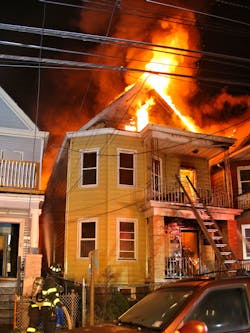The incident action plan (IAP) is an important part of managing any emergency incident and is used to set up the strategic objectives during a specific time frame or operational period.
For prolonged incidents that span multiple operational periods, a formal IAP is written, but the majority of emergency incidents use a verbal IAP that’s based off of a department’s standard operating procedures and standard operating guidelines, which establish incident priorities, including life safety, incident stabilization, property conservation and environmental protection.
How does one develop an IAP? Basically, you must have a plan for the plan. Breaking down the incident into segments is ideal to develop and manage the plan. These incidents can be divided into the following segments: en route, arrival, initial actions, scene management and under control/incident termination.
En route
Like everything else in the fire service, it starts with a size-up. So, here’s the question: When does a size-up begin? A firefighter, an officer and a chief of department probably will have a different answer based on the individual’s knowledge and experience.
A younger firefighter might say that it starts when an incident is dispatched. Officers and chiefs tend to think a little differently. For some, it begins days before the incident or when they wake up to start their day.
A size-up starts with the “knowns.” So, what is known? You know the time of year and week even before the tones drop. You know the current weather. These knowns help you to start to formulate the IAP even before you arrive at work or when the call is dispatched.
That said, there is a twist about knowns. There are “known unknowns.” Most of the time, the known unknowns can be referenced to the volunteer and combination sides of the fire service. In the volunteer and combination worlds, it’s difficult to know the exact manpower or the second-due apparatus. These known unknowns are dealt with on a daily basis.
When physically responding to the incident, you must couple the above with the information that you are receiving. This knowledge helps you to begin to formulate the IAP. Information is taken from several sources, such as dispatch and radio transmissions from police officers and accessing the computer-aided dispatch (CAD) system.
Even if you don’t have a CAD system, smartphones can provide so much information while responding to the incident. Just by simply speaking the address into the voice prompt, you immediately can get a map and directions to the incident. Apps, such as Google Maps, Google Street View and Google Earth, can provide a wealth of knowledge to responding companies and the incident commander (IC).
For example, Google Street View provides a daytime picture of a location, which will show you several important building and location characteristics prior to arrival. Knowing whether there is a large setback or there are power lines gives responding companies an added advantage for apparatus and line placement. Knowing the proximity of exposures also is key to developing the IAP.
Some other uses of technology, such as traffic cameras and Google searches of the incident address, can provide interesting information to help to shape strategy on how to mitigate the incident as safely and efficiently as possible. The use of technology isn’t just for the IC but for everyone who responds to the emergency.
Arrival
Once on scene, it’s important to obtain as much information about the incident in the shortest amount of time to make informed decisions. The IC must absorb the information, process it and release it to the responding units.
The initial radio report is one of the most important radio transmissions that the IC provides. This report paints a picture for the responding units for what they will encounter and sets the IAP in motion.
There are five parts to the initial radio report after establishing command:
- Building height
- Building construction type
- Building primary—and, possibly, secondary—occupancy uses
- What is happening at the incident (simple phrases, such as smoke or fire showing, alarms activated and the building is—or isn’t—being evacuated, are very important, because they will set many initial actions in motion upon arrival of the first-due companies)
- Drop the mic and go to work
Initial actions
Incident command size-up always is important and never really ends until the incident is over and you are waiting for the next run to come in. While commanding an incident, it’s important to go over key factors that will influence the strategy and tactics.
The fire service has been given a number of acronyms. One of the most popular command size-up acronyms was developed by Chief John Norman: COAL WAS WEALTH. Two letters were added by Deputy Chief Michael Terpak to make it COAL TWAS WEALTHS.
The latter breaks down as follows:
Construction, Occupancy, Apparatus & Staffing, Life Hazard
Terrain, Water Supply, Auxiliary Appliances & Aides, Street Conditions
Weather, Exposures, Area, Location & Extent of Fire, Time, Height, Special Considerations
These help the IC to work through the incident, which allows the IC to continue to modify the IAP as needed.
Resources are an essential part of the fire service as well as the IAP. Some resources are standard for every incident, but some incidents require additional resources. It’s important to get resources to the scene early to begin their specific tasks. Having a list of resources and their contact information at your command post speeds the process to get them on scene. The resource list can be put into a tactical worksheet.
Scene management
Tactical worksheets assist ICs in managing incidents and provide prompts for the IC to ensure that the incident is managed properly and efficiently. Because you can’t recall every action, the worksheet ensures that the i’s are dotted and the t’s are crossed. This also enables the IC to track several different objectives in one place.
Having a chief’s aide or command technician is beneficial to the IC to provide additional eyes and ears to manage the incident and to assure safety and efficiency on the fireground. The aide is essential to scribing what occurs at the incident and to tracking manpower and apparatus. If you don’t have an aide, assign one as quickly as possible.
An aide also can perform incident benchmarks and time checks that would prompt the IC to provide progress reports and to remind the IC of how long crews have been working. Knowing the operating length of time assists in decision-making based on the building’s construction and amount of fire.
Time stamps, benchmarks and similar information assist in overall strategy and in the IC’s ability to review, evaluate, and revise the strategies and tactics that are being employed, to ensure that the incident priorities and the IAP are aligned.
Communicating the IAP is accomplished by providing the strategic direction and tactical orders to the officers who operate at the fire. This is done via radio or face-to-face communication.
At a recent fire that involved a boarded-up, two-and-a-half-story wood-frame that had exposure issues, the companies initially were engaged in gaining entry, suppression and attempting to perform a primary search. Then, fire conditions changed drastically. The fire extended into two occupied multifamily dwellings (OMD) that were on either side of the original fire building. Immediately, it was communicated to the officers and members via radio and face to face to withdraw from the original fire building and to begin search and suppression efforts in the two OMD exposure buildings.
With three buildings on fire, additional alarms were transmitted. Additional water sources were needed to supply the multiple handlines and aerial master streams. The expansion of the incident required additional officers, to maintain the proper span of control.
A chief officer was assigned to the rear of the building to coordinate suppression efforts and to monitor safety concerns from the weakened fire buildings. The IC was able to obtain reports via radio as to the conditions, actions and needs of the companies that worked in the rear.
An additional officer was assigned as a safety officer to oversee the entire operation.
Once the fire was under control, companies were rotated through rehab and began the demobilization process, to release the additional alarm units. At this incident, the initial IAP was modified several times, because the circumstances dictated a change in actions. Quick and decisive communication prevented additional property losses, injuries and deaths.
Under control and termination
When the incident is placed under control, it’s important to perform a personal accountability report. This also is done when there is a change on the fireground, such as going from an offensive attack to a defensive mode. (The changing of modes will be reflected in the IAP because of the conditions.) Also, once the incident is under control, demobilization can begin. Releasing units that no longer are needed and getting on-scene apparatus/equipment pick-up are part of the IAP.
Terminating the incident has a few parts, including turning the property back over to the owner or manager. A verbal picture should be painted to dispatch as to what occurred and the actions that the department took to mitigate the incident. This is the last verbal report of the incident, and it can be used as a legal document in some jurisdictions.
Documentation of the incident is the final step. Completing the National Fire Incident Reporting System (NFIRS) report is an important way to document the incident and to provide vital information to the U.S. Fire Administration for data collection and resource allocation.
The IAP is the tool that manages each emergency incident. Some incidents and plans are longer and more in depth than others, but they all are important. Having a plan for how to handle each incident assists in commanding for the first 30 minutes and beyond.
About the Author

John Hayowyk Jr.
John Hayowyk Jr. has been in the fire service for 31 years. He recently retired as a battalion chief for the Passaic, NJ, Fire Department. Hayowyk spent more than half of his tenure assigned to truck companies, sharing time on the tiller and the tower. He also served as a lieutenant and a captain in the training division. Hayowyk has been a fire service instructor since 1997 and has taught at the Sussex County Public Safety Training Academy since 2002. He started his fire service career as a volunteer with the Roxbury Township, NJ, Fire Department and recently joined the Sparta Township, NJ, Fire Department. Hayowyk is New Jersey’s lead advocate for the National Fallen Firefighters Foundation and is an adjunct professor of fire science at the Sussex County Community College.

